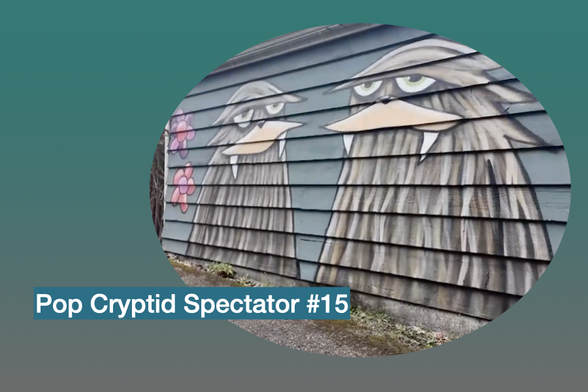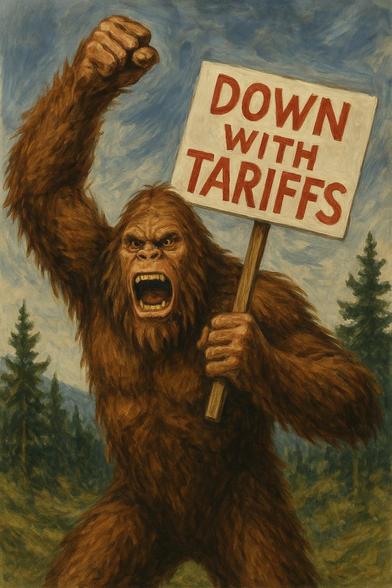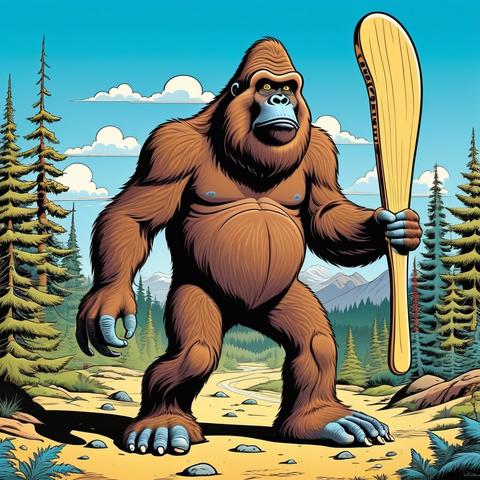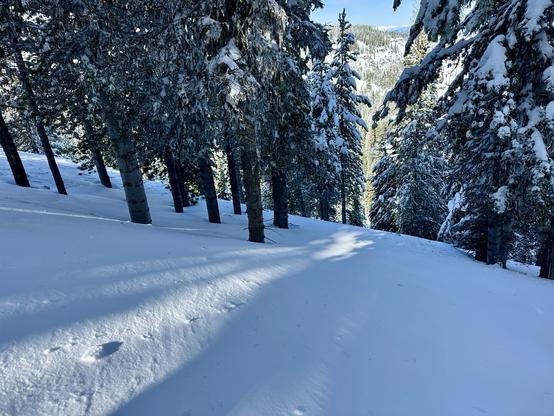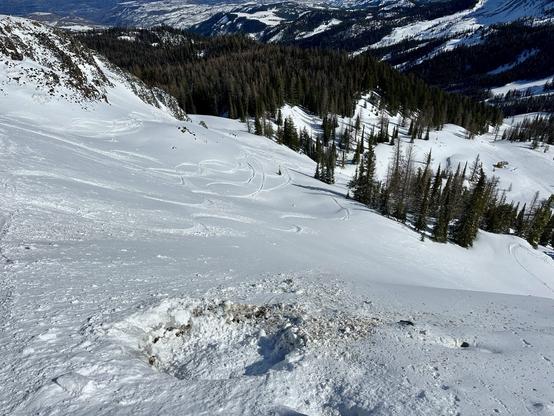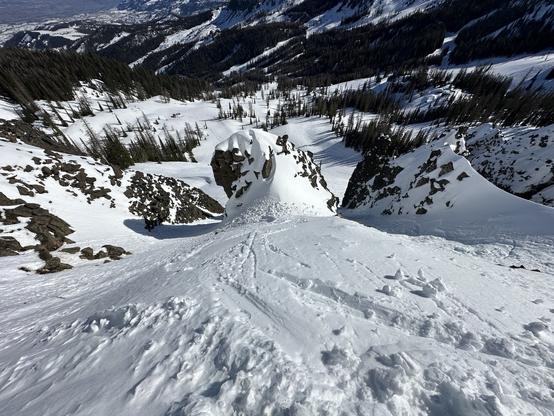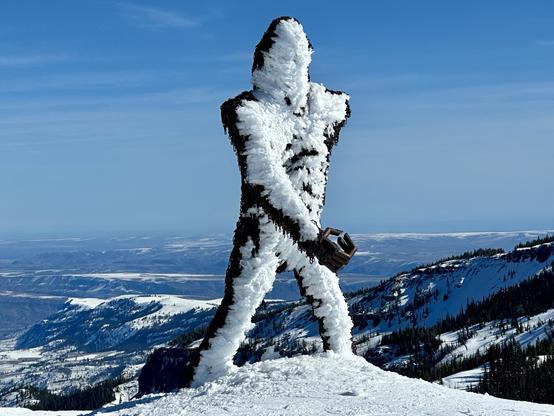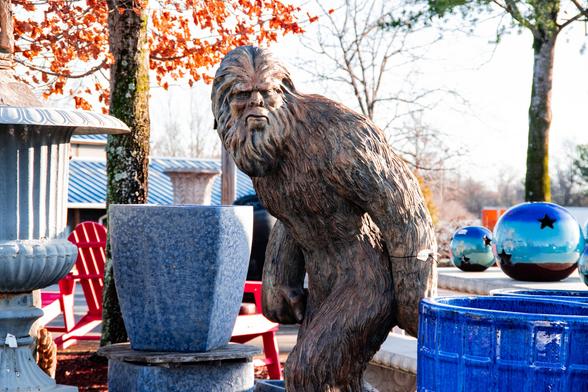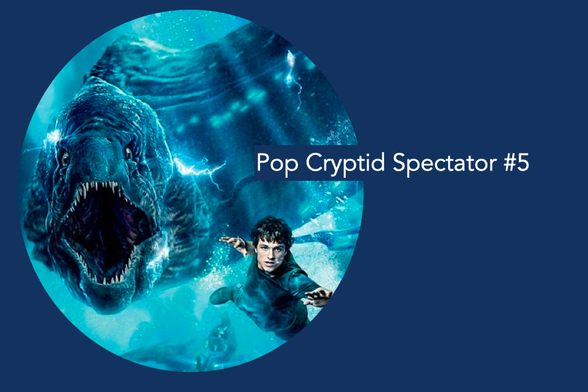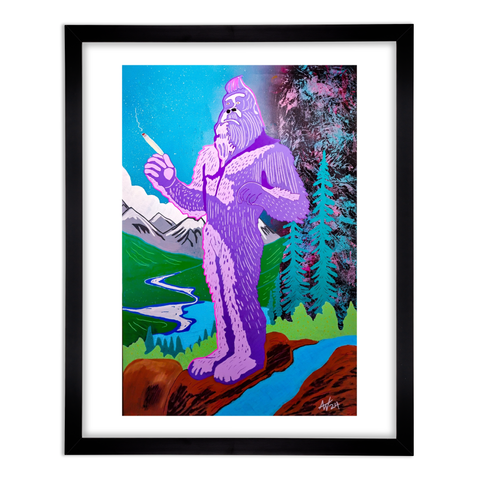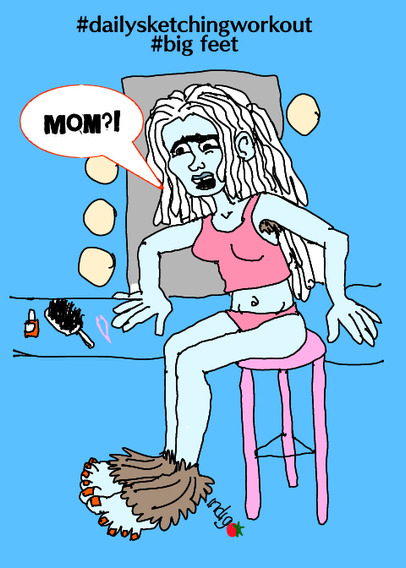JUNE is Sasquatch month! This week on Seddy Bimco Part Two The Revenge: We talk Bigfoot…because we talk about the 1970 movie, BIGFOOT! https://podcasts.apple.com/us/podcast/bigfoot/id1610761983?i=1000711142076 #sasquatch #podcast
#sasquatch
👀 @LoganFive spotted 👀
BREAKING NEWS: Sasquatch is real and he’s bigger than imagintion itself!! (Spotted above Tennessee).
Pop Cryptid Spectator 15
Hello and welcome to the 15 edition of Pop Cryptid Spectator – a newsletter solely meant to indulge my interest in the subject of cryptids in popular culture. If you’re reading it, that’s awesome; I appreciate it. It’s important to me to document changes in the thinking about mysterious animals over modern times. It’s not just some weird fringe subject, it’s mainstream now. The modern stories and events associated with mysterious animals reflect societal views and the different agendas of subgroups involved in the topic. This edition does go a bit heavy on the traditional view of cryptozoology, where people are interested in finding a real animal behind the rumors of existence. But, things will go off the rails, as everything has in this wacky 21st century. Thanks for joining me on this kooky trip.
In this edition:
- Florida Bigfoot Conference review
- Sasquatch heads around town
- AI cryptids: Faked Nessie sightings
- AI cryptids: Fake Yeti photo circulating
- AI Fake Coelacanth News
- Mokele-mbembe and Creationists’ corruption
- Cryptid media: The Cryptid Factor podcast
Florida Bigfoot Conference review
Amanda from Swell Entertainment attended the Great Florida Bigfoot Conference in Ocala a few weeks ago and posted a video review. I found several parts interesting but also, there was a lot of the same old thing that always happens with cryptid conferences (vs conventions which are more fan oriented). However, conferences usually suggest a more serious audience but cryptid events in general seem to be leaning more towards merchandise sales and para-celebrity attractions, with almost no scholarly presenters (maybe because there are so few).
For example, Amanda says there was considerable time given to the audience to supply content. That is, there was a panel discussion that was mostly audience questions, and there was a big session of testimonials where people were encouraged to tell their (sometimes long and rambling stories). Often, these events get one or two big name speakers from TV shows to draw fans. The quality of content is hit or miss.
Amanda didn’t have a strong background in Bigfoot information. This can be an advantage or disadvantage for a fair review. The advantage is that she had fresh eyes on the content and was unimpressed by the quality of much of the evidence presented, the over-reliance on eyewitness testimony, and poorly documented physical traces (like footprints). Additionally, she noted the drama that took place regarding a certain skunk ape researcher (if you know, you know – I know), who felt he should have been the main draw at this and previous events. Not only do these events not invite scholars (who are mostly going to be skeptics), they also have much ado about internal squabbles re: claiming areas, ideas, and even evidence, for themselves. All of this shows how “zoology” based cryptid research is unscientific. She even noted that very few presenters had a scientific background, and there was considerable fringe talk regarding conspiracies, government coverups, and even obvious nonsense about pseudoarchaeology and Roswell’s alien bodies. None of this is at all surprising.
From her comments, and from my past experience from such events, it seems that this event really leans into an agenda that transcends Bigfoot as simply a mystery to be solved. Going by the popularity of UAPs and eccentric ideas about nature, a portion of Bigfoot audiences will buy into scary concepts without foundation, where belief and personal testimony outweigh scientific evidence and critical evaluation. That’s not rational, that’s religion.
https://www.youtube.com/watch?v=mTiOZXToRk8
Sasquatch heads around town
Moving on to a more lighthearted, and very “pop cryptid” story, Seattle artist Henry is on a mission to paint 1000 Sasquatch faces across the city. He loves to create his cartoon, friendly-fanged version of the big guy and thinks it’s a nice way to connect the community with a common theme. He is still taking requests for locations on his website https://www.henry.art/1000-murals.html, if you have a spare space that needs a furry face.
AI cryptids: Faked Nessie sightings
I really didn’t anticipate that so many cryptid stories in the news would roll back around to AI. But with this slop taking over the internet and making that technology less useful every day, this is the way it’s going. The Loch Ness Centre has to consider that every photo they get purportedly of Nessie might be AI generated. In past decades, photo editing and hoaxes was a likely possibility, but now, the photos can be not only heavily manipulated through AI, but created entirely from prompts, not even needing some real event as a basis. The Centre has had to employ a team of consultants to examine the visual evidence for this kind of humbuggery.
Actually, the easier route is to not accept this kind of evidence at all. The odds are overwhelming that any image is not going to show anything worthwhile. Evidence needs to be far better than that.
AI cryptids: Fake Yeti photo circulating
For this story, I’m trying not to despair because the content is so blatantly fake that it should be obvious to anyone. But people still are circulating it as evidence of the Yeti. It’s so popular that Snopes.com had to put up a debunk of it. It began with an AI generated photo appearing on X (which I always call Xitter, pronounced “shi-ter”) showing a weird bear-like creature next to a man. It got over a million views. Within a few weeks, the image was being circulated on TikTok as evidence of the Yeti. This is not the first time that AI has been used to fool people with photo evidence of a hairy giant and other cryptids. The internet is making us stupid. I just hope most people see this as a form of modern art/commentary, and not real.
AI Fake Coelacanth News
And, finally, on the AI front, is the fake news circulated this week that a coelacanth (a cryptozoologist’s favorite red herring for mystery monsters that may still exist) was found off the coast of California. I wrote a separate post about this which you received if you are subscriber. It’s a depressing state of affairs when news media will simply regurgitate fiction as fact without checking. But this is a warning that it’s happening all the time and we need to be aware. Be SKEPTICAL! Check the sources.
Mokele-mbembe and Creationists’ corruption
In the past few PCS editions, I’ve mentioned the growing popularity of neodinosaurs (a term that was coined by Fortean and OG cryptozoology commentator Ivan Sanderson). In particular, the mokele-mbembe stories are showing up on media sites documenting the resurgence of belief by locals that a brontosaurus-like creature still exists in the Congo basin in Africa. A new piece from New Lines mag continues the story by emphasizing the connection of this tale to those trying to disprove evolution. The article packs a punch. I have to share a quote:
Mokele-mbembe is the Congo Basin’s bigfoot. Or that’s what it’s become, anyway — a cryptid. Nobody is sure when the myth originated, but it was born among the basin’s communities, who passed it down as an oral tradition. Locals tell me the myth was spiritual at first — a metaphor, perhaps, for humankind’s delicate relationship with the land. But today, nobody can say with certainty what exactly it meant because foreigners long ago twisted it well beyond recognition.
“Congolese people originally believed mokele-mbembe was a spiritual being, not a real dinosaur,” Oyange told me last year. “But that all changed when the white man came to Africa.” A confluence of European colonial expansion into Africa and the birth of paleontology gave rise to a version of mokele-mbembe that was a literal, flesh-and-blood, swamp-dwelling reptilian beast. Tales passed around by explorers, missionaries and colonial functionaries became warped by notions from Victorian literature and emerging science.
Take. Note. It is perfectly clear that the idea of a living dinosaur in the Congo was a manufactured myth. Unfortunately, it is still heavily promoted by a few backwards thinkers who insist that the Bible is a science book. And, worse than that, the locals now believe the modern myth. Similarly, the ideas of lake monsters and many other cryptids, especially Bigfoot, were linked to native stories by white people even where there was originally no strong similarity to the creature in the folklore. In time, the oral traditions merged with modern media depictions and the distinction between the two is lost, even to the point where modern Natives will equate their ancient tales to the manufactured media version of the creature. There have been several studies showing that when you go back to the original native tales of supernatural creatures, they do not resemble the exaggerated named cryptid of today. This article is worth a read.
Cryptid media: Cryptid Factor podcast
And now for something completely comedic. I have been listening to The Cryptid Factor when it was a radio show that turned into a podcast. I can’t remember the year I first heard it but I think it was 2008 or 2009. It was one of the earliest cryptid-related podcasts, though I use that term “cryptid-related” loosely. It’s more “cryptid-themed”. It wasn’t always easy to keep up. There were long breaks between episodes. For example, they are officially up to episode #106 in the 17 years that the show has been in existence. That’s 6.23 episodes per year. However, I forgive them because it’s hosted by TV and movie actor Rhys Darby, whom I first knew from one of my favorite shows, Flight of Conchords. Rhys is a busy guy, even appearing on the special X Files series event in 2016 as a cryptid himself. So the podcast crew couldn’t always manage a regular schedule. In the past 5 years, I gave up listening because I figured it was defunct. Instead, interest was surging on the pop cryptid wave! When I resubscribed a few months back, I realized that their fandom had expanded. Rhys and his cohosts now regularly promote the show, it’s on YouTube and they have a Shopify merch site! Clearly, hanging on to the brand through the lean times paid off. If you search for “cryptid” on BlueSky or Instagram social media feeds today, you’ll get Rhys as part of the results!
Like I said, the show is more comedic than anything. It’s all about having fun and being very silly. After all this time, I’m still not sure what the crew really believe or disbelieve but it doesn’t matter (since I have a liking for New Zealand accents). They have a genuine interest, but still not too much in depth knowledge, about cryptids and related subjects. I do credit Rhys for introducing me to the concept of the Taniwha (a mysterious creature of New Zealand that sort of serves as the catch-all monster, like the Bunyip of Australia). Even though the main purpose of the podcast appears to be an excuse for a trio of zany friends to make jokes and humorous sound effects, talk about their international travel, and “weekly” weird news stories, occasionally, some cryptid content is included. I love it. The Cryptid Factor was totally part of the Pop Cryptid scene before it even began!
Thanks for reading! Send comments, questions, or suggestions to sharon(at)sharonahill.com. If you want to send some cryptid plushies or other merch, or books to review, email for my physical mailing address.
For more, click on Pop goes the Cryptid landing page. Make sure you subscribe to all the posts – it’s always free and I don’t send annoying spam.
Pop Cryptid Spectator is also available on Substack. Please share this with cryptid fans you know!
Pop Cryptid Spectator Pop Cryptid Spectator 14Pop Cryptid Spectator 13
Pop Cryptid Spectator 12
Pop Cryptid Spectator 11
Pop Cryptid Spectator 10
Pop Cryptid Spectator 9
Pop Cryptid Spectator 8
Pop Cryptid Spectator 7
Pop Cryptid Spectator 6
Pop Cryptid Spectator 5
Pop Cryptid Spectator 4
Pop Cryptid Spectator 3
Pop Cryptid Spectator 2
#1 #2 #AICryptids #Bigfoot #BigfootHuntersDie #cryptid #cryptidFake #cryptidTVShow #giantOwls #GodzillaSighting #GoogleEarth #HoodCryptids #OutThereCrimesOfTheParanormal #popCryptids #scryptids #Skinwalker #TheCryptidFactor #Wendigo
Avenue of the Giants Eel River Humboldt Redwoods State Park California #BigFoot #Sasquatch
Had to happen eventually. #bigfoot #Sasquatch #cryptid
Every time this video pops up, I play it because it makes me happy 😊
CNN: Homeland Security Secretary Kristi Noem visits El Salvador prison where deported Venezuelans are held
https://www.cnn.com/2025/03/26/americas/kristi-noem-salvador-prison-visit-intl-latam/index.html
"But know that this facility is one of the tools in our toolkit that we will use if you commit crimes against the American people."
---
Hey #Sasquatch what crimes did these men commit against the American people exactly?
Your tool kit?
You sound fucking dumb.
The skunk ape is a hairy cryptid said to inhabit the forests and swamps of the southeastern United States, especially Florida. It resembles Bigfoot, but is thought of as smaller, closer to an average human in height. The skunk ape produces a foul, skunk-like odor.
🎨 Jaxson
#WyrdWednesday #31DaysofHaunting #Superstitiology #Mythology #Folklore #Cryptozoology #Cryptid #Monster #BigFoot #Sasquatch #SkunkApe #DontGoIntoTheWoods
1973 story about searching for a sasquatch or bigfoot in the Alaska ghost town of Portlock, from the Alaska Living magazine insert for the April 15, 1973 Anchorage Daily News #alaskahistory #bigfoot #sasquatch #alaska
After traversing through the woods, I found these strange indentations in the snow. Faced with some challenges navigating the steep terrain, I opted to go left and thats when... I found a frozen Sasquatch! 🥶
You never know what you might find in the mountains!?
#snowboarding #Sasquatch #mountains #MountainMonday #MissionRidge
You see a sasquatch approaching you. What do you do?
#furryart #sasquatch #male #sfwfurryart #commsopen
I'm not sure why God didn't choose to Big Boing the universe. I guess boings don't create humans. #Bigfoot #Sasquatch
I have to say I don't amuse everyone...part 3. 📷 Pentax K-70 🔘 Pentax 18-135mm APS-C (shot at 60mm) 📷 1/60 at f/5.6 with ISO of 200 #photography #streetphotography #bigfoot #sasquatch #yeti #Pentax
am i real ?
#bigfoot #sasquatch
Pop Cryptid Spectator 5
Hello and welcome to the 5th Pop Cryptid Spectator – my chronicle of observing the changing appearance of and attitudes towards “cryptids” in popular culture.
My interest is in exploring the expansion of cryptozoology into a mass cultural phenomenon. This edition provides more examples of how cryptids are part of our everyday lives. They are a way of framing the world in terms of mystery and wonder about monsters, and animals that may still be out there to find. Or, they are useful as liminal creatures formed from and existing only in our imaginations, or on the internet, but that we enjoy believing are real.
In this edition:
- Bigfoot makes an appearance in a divorce case
- Sidenote – Hunt for the Sasquatch race
- The Times of London promotes growing belief in Bigfoot
- E-DNA and the Enormous Eel Effect
- Sidenote – Excited whale parts
- The Utah Yetis dream dissolves
- Reality Shifting and Cryptids
- The Goosepig of Alexandria, Virginia
Bigfoot makes an appearance in a divorce case
A recent news story shows how important Bigfoot is to some peoples’ personal identity, so much so that it impacts their relationships and their work life. A man in British Columbia lost a claim for spousal support after a judge concluded that if he was capable of hunting Bigfoot, he was capable of getting a real job. The judge made multiple references to the unnamed man’s love for “camping, fishing, hunting, riding ‘quad’ motorcycles, and exploring remote areas of B.C. in search of sasquatch”. During a camping trip in 2020, the man was joined by an ex-girlfriend, who apparently shared his interest in cryptid hunting, without the wife’s knowledge. This led to the dissolution of the marriage. He claimed that a fall in 2016 while on a Sasquatch expedition caused him injuries and chronic pain that still prevented him from being able to work. The judge did not agree since evidence was provided that his still pursued his hobby and he had a capable brain for jobs that didn’t involve physical exertion. Sounds like he might do well as a Bigfoot reality TV star.
Sidenote – Hunt for the Sasquatch race
In a tangentially related side note, a Bigfoot “hunt” for the more physically fit occurs in Polk County, Florida on February 1 when Parks and Recreation will host its 9th annual The Hunt for Sasquatch trail race. Here’s hoping the winner finds a Sasquatch!
The Times of London promotes growing belief in Bigfoot
The Times (UK) has an article out this week, which highlights the continued interest in Bigfoot. Unfortunately, however, it features Matt Moneymaker of the Bigfoot Field Research Organization and Finding Bigfoot TV show, a person who is less than reasonable or cordial to anyone who doesn’t unquestionably accept his fringe claims. Just skip over his parts to see that the article states Bigfoot is “one of the most enduring myths in the United States has inspired a thriving subculture”. The writer cites a 2022 poll that shows 13% of American adults agreed with the statement that Sasquatch is a real, living creature, and suggests that percentage is growing. There is an unavoidable problem when polling people about beliefs, or anything else – they give you their opinion of the moment. This is heavily influenced by the media they consume and maybe the last person they talked to about it, or perhaps they answer “Sure, why not?” just because they are in a cheeky mood. We don’t know. But it is a reasonable estimate for interest in the subject for that particular population sampled.
E-DNA and the Enormous Eel Effect
In 2019, Professor Neil Gemmell, a geneticist from the University of Otago in New Zealand, used eDNA collection procedures and analysis at Loch Ness. The result was a bit of a bust since he found no mystery DNA that provided evidence of an unknown animal in the lake. But, he found lots of eel DNA, and then, inappropriately concluded that there may be giant eels which might be what people are seeing in that loch. Gemmell hit the jackpot by hooking his research to Nessie as it made headlines worldwide. The giant eel nonsense has reared its head out of the water again.
Prof Gemmell is once again planning to head back to the lake for Loch Ness 2.0 where he wants to use a different type of DNA sequencing to show the proportional change in a species’ population over time. The project has real world value regarding biodiversity, but Gemmell continues to use Nessie as the gimmick for attention even though he doesn’t expect to find a monster (eel or otherwise).
“[L]ast time around with Loch Ness 1.0, being able to capture that excitement and communicate it to the world was so much fun.”
He might still be pushing the big eel idea that no knowledgable Nessie researcher takes seriously. Of course there are eels in Loch Ness, but there is no evidence, not even DNA, that suggests a giant eel lives there. Gemmell erodes his cred by taking such a leap, previously saying, “Well, our data doesn’t reveal their size, but the sheer quantity of the material says that we can’t discount the possibility that there may be giant eels in Loch Ness. Therefore we can’t discount the possibility that what people see and believe is the Loch Ness Monster might be a giant eel.”
The enormous eel trope stuck with other DNA researchers too. When Prince William was visiting scientists at NatureMetrics, a research lab near London that also uses eDNA processes, he joked, “Does this mean you can find the Loch Ness Monster?” Firm founder Dr. Kat Bruce then claimed that the so-called creature was more likely a “very big eel” — at least according to testing done on one of the world’s most infamous lakes. Ugh! Silly ideas can be so sticky!
Sidenote – Excited whale parts
In the same Prince William article, the NY Post tabloid also printed that “A few years back, one daring academic proposed that the mythical beast is actually a “whale’s penis” — only to retract the whopper of a theory after being ridiculed mercilessly.” That’s incorrect. The whale penis suggestion is not ridiculous – the appearance of such a spectacle almost certainly happened in the past and threw observers for a loop – but it was in relation to sea serpents, not lake monsters like Nessie. For more on that story – see this compilation. (It’s SFW.)
The Utah Yetis Dream Dissolves
Here’s an update on the story from Pop Cryptid Spectator #4, there will be no new cryptid-named NHL team. You can thank your vacuum-sealed double-walled water bottles and coolers. The Utah hockey club stated the following: “An SEG executive shared that it explored every avenue to make Yeti work but that YETI Coolers, LLC was ultimately unwilling to agree to a co-existence agreement. SEG has confirmed it is no longer pursuing Yeti as a potential name for the team.” That’s a real shame. The next best name is the Mammoth, especially since mammoths did once roam the area now known as Utah.
Reality Shifting and Cryptids
There is an undeniable rift in the cryptozoology scene now. On one side is the idea that cryptids exist in our reality – that we can search for them, maybe find them, even if they have non-natural attributes. On the other side is that cryptids are made part of our reality because we put them there, we create them, and believe in them for strong personal reasons. For the latter, discovery is not the goal. The creatures exist in our defined reality because we allow them to and they serve a purpose that is not zoological.
If you are still following along and haven’t rolled your eyes and checked out, I thank you. I think the concept of reality shifting is important to why we are are experiencing the explosive growth of “cryptid” in its popular context, why cryptid cosplay and merchandise is so popular, and why cryptids are now incorporated into how some define their identity.
Reality shifting is a deliberate activity where a person, usually under the age of 30 (a generation known as Gen Z or Zoomers, born after 1996), decides to construct their own reality and live in that instead of the stressful, unrewarding, day-to-day grind of modern times. The world feels unreal and upside down to many people, so they go online. While the concept of reality shifting appeared in 2019, Covid lockdown created a surge of people constructing their alternate reality. People who create their own fantastical reality can include cryptids or even be cryptids themselves.
Internet folklorist, Gunseli Yalcinkaya, writes about reality shifting. And, she is also a huge fan of cryptids. I was introduced to her work via the Reality Studies vidcast from August 2024. Calling reality shifting an “ascendant form of zoomer spiritualism”, she talks about the development of shared fantasies online, where reality and fantasy merge. People take up a desired reality as a form of escapism and creative expression. The current internet landscape makes this very easy to do.
“To imagine the cryptid – a creature that is by definition unknowable – demands us to suspend real-world rules and immerse ourselves in the fantasy of what’s ‘out there’. […] The desire to uncover hidden truths extends across our post-truth landscape, from the tin-hat conspiracies we consume, to our ongoing fascination with creepypastas like Slenderman and Loab, and the UFOria sweeping across the mainstream. Similarly, we cannot fully comprehend the cryptid because it exists outside the human world.” – Gunseli Yalcinkaya
Gunseli talks about cryptids mostly in the pop cryptid framework, which is where she excels, but sometimes slips into the old timey cryptozoology tropes. She defines cryptids as creatures that may or may not exist under a Western scientific framework, in the sense that any undiscovered animal is a cryptid. She counts interesting animals, like the gorilla, as cryptids prior to them being discovered; I don’t agree with framing historical finds as cryptid prior to the establishment cryptozoology as a thing. But she has keen insight into the modern view of cryptids that sci-cryptozoology lacks. In one article, she noted that the appeal of Bigfoot may be that it manages to “exist” in reality, or as just an icon, but still manages to avoid being overtaken, tracked, and captured by technology. Her way of using cryptid, however, is often missing the concept of it being “ethnoknown” (a subject that exists in prior human knowledge, usually from local cultural tales). The minimizing, or total loss, of the historical, anecdotal basis for cryptids is evident with new AI cryptids that appear online – LOAB, crungus, and erosion bird. They are shared online in a form of “existing” but their origin is hidden; it remains unclear how or why they appeared. They might appear so often in your online environment that they begin to feel “real”. If any faked or fictional thing sticks around long enough, it can become real – like when fakelore turns into folklore and people tell the stories about encoutering the creatures that originated in Internet liminal space.
I talked about AI cryptids in the Pop Cryptid Spectator #2, but there far is more to be said on these creatures. I know that talking about very modern pop cryptids, from the view of the “extremely online” population of mostly young people, is so far from the original concept of cryptozoology that it makes many people uncomfortable. But fields of study evolve in response to changes in society and technology. That is certainly happening with cryptozoology.
Check out this talk by Gunseli called Cryptid: A Theory of Post-Digital Selfhood for some more brain stretching exercises. I really love the statement early on that the cryptid is defined by the “patchwork of stories” about it.
https://www.youtube.com/watch?v=H0X8C8WmCUM
The Goosepig of Alexandria, Virginia
A fakelore cryptid is thriving at Spa Spring in Alexandria, Virginia. The “goosepig” legend gets a boost by appearing on signage designating historical areas. The creature, resulting from the cross-breeding of pigs and geese, derived from the town’s history of banning these two animals from the city via a local ordinance. Pushed to the fringes, they interbred creating an impossible four-legged animal with a beak. The source of the story on the historical marker is a book on local pets dated 1972. But the story derives from tales referenced from 1928. It might have circulated even earlier as a town historian says that swine and geese were banned from the town beginning at least around 1811.
The new Alexandria Historical Sign Finder map will certainly help boost the goosepig story as more people will find and popularize the sign celebrating the creature. Although the animal is fake, it represents a social event that pushed livestock, and a way of living, out of a city aiming to modernize. While the goosepig does not qualify as a “mysterious animal” in terms of the original intent of “cryptid”, it is set to become a pop cryptid similar to the Hodag of WI and the Squonk of PA. Next logical step is for a goosepig festival to appear!
For more, click on Pop goes the Cryptid landing page. Make sure you subscribe to all the posts – it’s always free and I don’t send annoying spam.
You can email me with comments, suggestions or questions at Popcryptid(at)proton.me
Pop Cryptid Spectator is also available on Substack. Please share this with cryptid fans you know!
#2 #4 #Bigfoot #cryptid #EDNA #GiantEel #Goosepig #LochNess #Nessie #popCryptid #PopCryptidSpectator #PopGoesTheCryptid #Sasquatch #utahYetis
"Do I Exist?!?"
24x36 Acrylic on Canvas
UV Reactive
Original AVAILABLE
Asking 777
IG:Artbyanthillant
Prints Available below
https://anthillant.threadless.com/designs/do-i-exist-1/home/fine-art-print
Artbyanthillant.bsky.social
#SupportTheArts #Art #Sassyquatch #Bigfoot #Sasquatch #Illustration #BaltimoreArtist #PopArt #Existentialism #Posca #Artist
#dailysketchingworkout
Prompt 3625: Big Feet
"Eevie's mom had always known the day would come when she would need to explain her daughter's half-Yeti, half-Sasquatch heritage."

